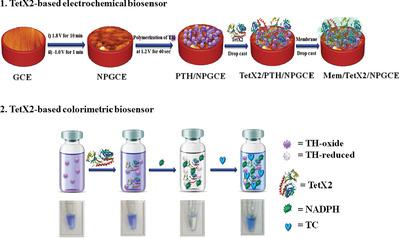当前位置:
X-MOL 学术
›
Biotechnol. Appl. Bioc.
›
论文详情
Our official English website, www.x-mol.net, welcomes your
feedback! (Note: you will need to create a separate account there.)
Novel enzyme-based electrochemical and colorimetric biosensors for tetracycline monitoring in milk
Biotechnology and Applied Biochemistry ( IF 3.2 ) Pub Date : 2020-11-23 , DOI: 10.1002/bab.2078 Maryam Besharati 1, 2 , Mahmoud Amouzadeh Tabrizi 3 , Fatemeh Molaabasi 4 , Reza Saber 5 , Mojtaba Shamsipur 6 , Javad Hamedi 1, 2 , Saman Hosseinkhani 7
Biotechnology and Applied Biochemistry ( IF 3.2 ) Pub Date : 2020-11-23 , DOI: 10.1002/bab.2078 Maryam Besharati 1, 2 , Mahmoud Amouzadeh Tabrizi 3 , Fatemeh Molaabasi 4 , Reza Saber 5 , Mojtaba Shamsipur 6 , Javad Hamedi 1, 2 , Saman Hosseinkhani 7
Affiliation

|
Recently, there has been a growing demand to develop portable devices for the fast detection of contaminants in food safety, healthcare, and environmental fields. Herein, two biosensing methods were designed by the use of nicotinamide adenine dinucleotide phosphate (NAD(P)H)-dependent TetX2 enzyme activity and thionine as an excellent electrochemical and colorimetric mediator/probe to monitor tetracycline (TC) in milk. The nanoporous glassy carbon electrode (NPGCE) modified with polythionine was first prepared by electrochemically and then TetX2 was immobilized onto the NPGCE using polyethyleneimine. The prepared biosensor provided a high electrocatalytic response toward NAD(P)H by significantly reducing its overpotential. The proposed biosensor exhibited a detection limit of 40 nM with a linear range of 0.1–0.8 μM for TC determination. Besides, the thionine probe was used to develop a novel colorimetric assay using a simple enzymatic color reaction within a few minutes. The limit of detection for TC was experimentally achieved as 60 nM, which was lower than the safety levels established by the World Health Organization (225 nM). The correlation between change in the color of the solution and the concentration of TC was used for quality control of milk samples, as confirmed by the standard high-performance liquid chromatography method. The results show the great potential of the proposed assays as portable instruments for on-site TC measurements.
中文翻译:

用于监测牛奶中四环素的新型基于酶的电化学和比色生物传感器
最近,人们越来越需要开发便携式设备,以快速检测食品安全、医疗保健和环境领域的污染物。在此,设计了两种生物传感方法,利用烟酰胺腺嘌呤二核苷酸磷酸 (NAD(P)H) 依赖性 TetX2 酶活性和硫氨酸作为一种优异的电化学和比色介质/探针来监测牛奶中的四环素 (TC)。首先通过电化学制备用聚硫氨酸修饰的纳米多孔玻璃碳电极 (NPGCE),然后使用聚乙烯亚胺将 TetX2 固定在 NPGCE 上。制备的生物传感器通过显着降低其过电位,对 NAD(P)H 提供了高电催化响应。所提出的生物传感器的检测限为 40 nM,TC 测定的线性范围为 0.1-0.8 μM。除了,硫氨酸探针用于开发一种新的比色测定法,在几分钟内使用简单的酶促颜色反应。TC 的检测限在实验上达到了 60 nM,低于世界卫生组织制定的安全水平(225 nM)。标准高效液相色谱法证实了溶液颜色变化与 TC 浓度之间的相关性用于牛奶样品的质量控制。结果表明,所提出的测定作为现场 TC 测量的便携式仪器具有巨大潜力。这低于世界卫生组织制定的安全水平(225 nM)。标准高效液相色谱法证实了溶液颜色变化与 TC 浓度之间的相关性用于牛奶样品的质量控制。结果表明,所提出的测定作为现场 TC 测量的便携式仪器具有巨大潜力。这低于世界卫生组织制定的安全水平(225 nM)。标准高效液相色谱法证实了溶液颜色变化与 TC 浓度之间的相关性用于牛奶样品的质量控制。结果表明,所提出的测定作为现场 TC 测量的便携式仪器具有巨大潜力。
更新日期:2020-11-23
中文翻译:

用于监测牛奶中四环素的新型基于酶的电化学和比色生物传感器
最近,人们越来越需要开发便携式设备,以快速检测食品安全、医疗保健和环境领域的污染物。在此,设计了两种生物传感方法,利用烟酰胺腺嘌呤二核苷酸磷酸 (NAD(P)H) 依赖性 TetX2 酶活性和硫氨酸作为一种优异的电化学和比色介质/探针来监测牛奶中的四环素 (TC)。首先通过电化学制备用聚硫氨酸修饰的纳米多孔玻璃碳电极 (NPGCE),然后使用聚乙烯亚胺将 TetX2 固定在 NPGCE 上。制备的生物传感器通过显着降低其过电位,对 NAD(P)H 提供了高电催化响应。所提出的生物传感器的检测限为 40 nM,TC 测定的线性范围为 0.1-0.8 μM。除了,硫氨酸探针用于开发一种新的比色测定法,在几分钟内使用简单的酶促颜色反应。TC 的检测限在实验上达到了 60 nM,低于世界卫生组织制定的安全水平(225 nM)。标准高效液相色谱法证实了溶液颜色变化与 TC 浓度之间的相关性用于牛奶样品的质量控制。结果表明,所提出的测定作为现场 TC 测量的便携式仪器具有巨大潜力。这低于世界卫生组织制定的安全水平(225 nM)。标准高效液相色谱法证实了溶液颜色变化与 TC 浓度之间的相关性用于牛奶样品的质量控制。结果表明,所提出的测定作为现场 TC 测量的便携式仪器具有巨大潜力。这低于世界卫生组织制定的安全水平(225 nM)。标准高效液相色谱法证实了溶液颜色变化与 TC 浓度之间的相关性用于牛奶样品的质量控制。结果表明,所提出的测定作为现场 TC 测量的便携式仪器具有巨大潜力。











































 京公网安备 11010802027423号
京公网安备 11010802027423号